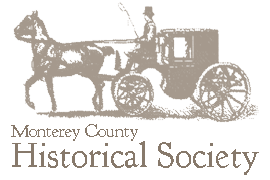The site of Mission San Juan Bautista was chosen for founding of the sixteenth mission on June 24, 1797, because it promised an “abundant harvest of souls” in the fertile San Juan Valley. From 1803 to 1812 the resident Indians labored at construction of the quadrangle complex, which included a 190 foot long church and a beautiful corridor of 20 arches, all constructed of fired adobe brick. Mission teachings continued under Father Tapis from 1812 to 1825, while the mission gained a highly regarded reputation for the quality of neophyte education and Padre Tapis’ diplomacy in dealing with government officials and military officers living at San Juan Bautista.
The mission received an influx in population during 1824 from the Tulare Valley, quite possibly as a result of the aggressive expeditions to the interior territories by the military at that time. The population had peaked during 1823, with 641 male and 607 female residents. A total of 22 adobe dwellings for Indians had been constructed that year (obviously most lived in tule houses or on nearby rancherias), and reports were made of adobe corrals, a granary, a kiln, and weaving rooms restored with the new large labor force. The padres reported that wages paid to the Indians for skilled services included 4 reales a day ($0.50) for woodcutters, 3 reales ($0.375) for sawyers, and 1.5 reales ($0.1875) for laborers.
The 1827 report filed to the governor listed mission livestock and rancho lands. To the southeast and northeast of the mission on low hills and plains the Indians tended 6,500 head of cattle, 502 mares, 250 tame and broken horses, and 37 mules. To the east they maintained a rancho for the mission sheep. To the northeast a rancho was maintained for mission livestock. To the north-northeast another rancho was kept, where the stock grazed on small plains and low hills near springs. No irrigation was practiced on any of these mission ranchos. To the north-northeast, lying three leagues from the mission and El Camino Real, the mission held a rancho for sheep with pasturage on the sides of high mountains. In the center of these mountains were found deposits of pitch and sulfur, as well as sulfurous hot and cold springs. The pastures were watered by the overflow of El Rio de Pajaro. No more mission lands were held in that direction because Spanish land grants had been made for two large parcels, the Rancho de las Animas (southern Santa Clara Valley) and Rancho de Solis. The mission obtained good timber from this area as well. To the west-northwest was a rancho for sheep, three leagues from the mission, bordering the Rancho de Aro. Immediately to the west of these lands were the ranchos of Antonio Castro (Pajaro) and the Picos and Vallejos, with the Brea Springs of the Pajaro running towards them. To the southwest was Rancho San Miguel, or Los Espinosas. To the south-southeast lay the sheep ranch of Natividad, as well as the Spanish concession to Butron and the ranchos Alviso, Alisal, and Sausal, all on a small arroyo. To the south of the mission was the grand elevation of Gavilan, from which springs ran to irrigate the mission gardens, vineyard, and cornfield.
Following secularization, San Juan became a pueblo. The mission property was inventoried in 1845 by Pio Pico’s brother Andres, who listed at the mission a parish house of 16 rooms made of adobe with brick tile and packed clay floors and tile roofs. The garden to the north of the complex and an orchard of 875 fruit trees were surrounded by a wall constructed of old cattle bones. The abandoned vineyard still held 1,200 vines. Total mission land at that time consisted of 7,500 square varas. When title was restored to the church in 1859, Mission San Juan Bautista lands comprised 55.13 acres.
Sources:
- Breschini, G.S., T. Haversat, and R.P. Hampson, A Cultural Resources Overview of the Coast and Coast-Valley Study Areas [California] (Coyote Press, Salinas, CA, 1983).
- Engelhardt, Z., Mission San Juan Bautista: A School of Church Music (Mission Santa Barbara, Santa Barbara, CA, 1931).
- Hoover, M.B., H.E. Rensch, and E.G. Rensch, Historic Spots in California, third edition (Stanford University Press, Stanford, CA, 1966).


